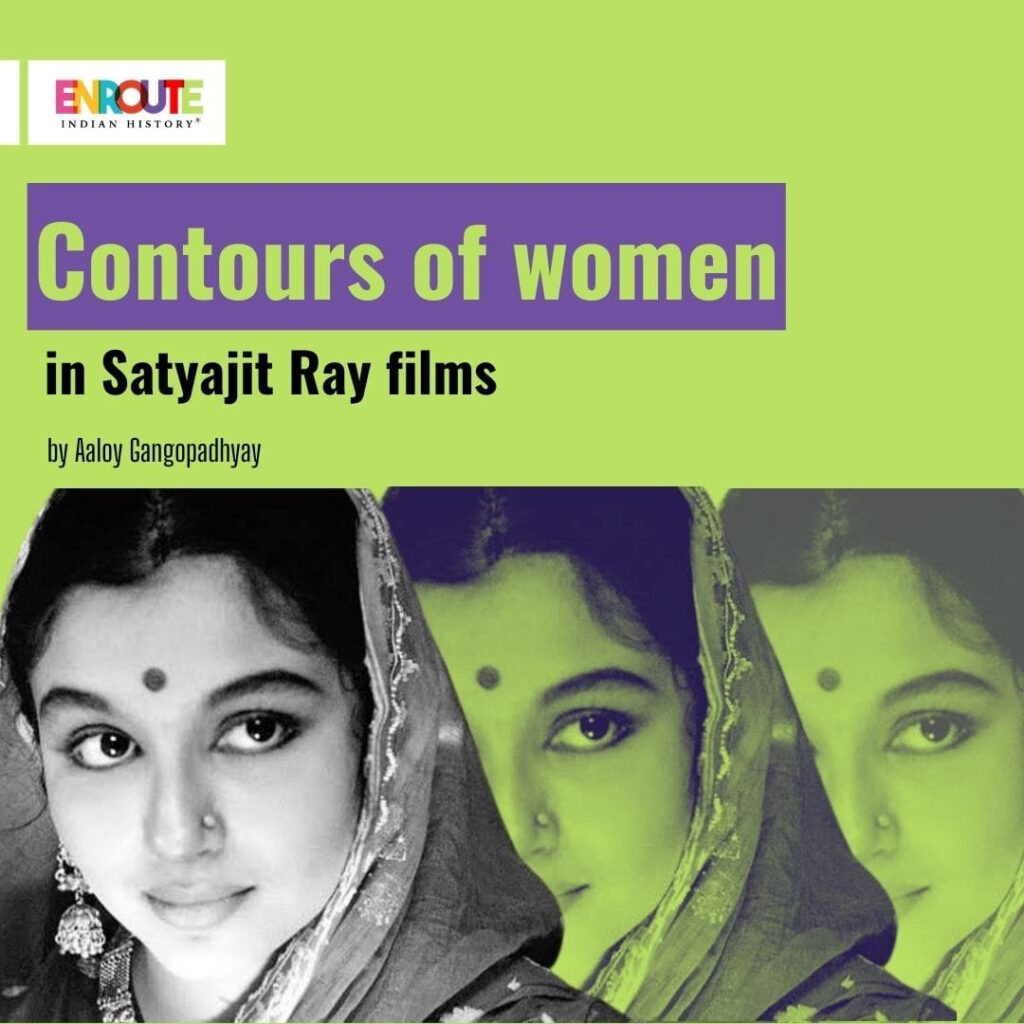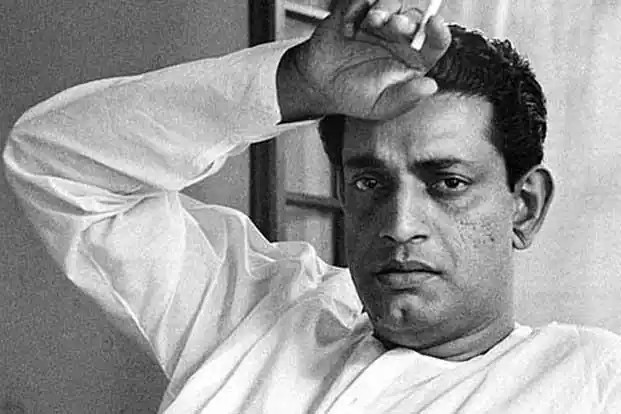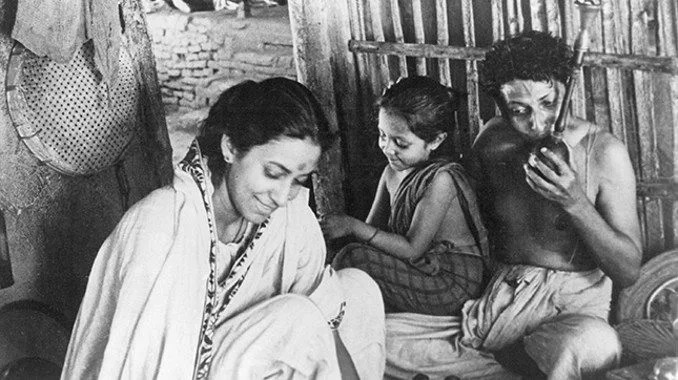
Article Written By EIH Researcher And Writer
Aaloy Gangopadhyay
With the ongoing birth centenary celebrations of the doyen of Indian Cinema, Satyajit Ray in full swing, I feel privileged to contribute in obeisance. Apart from movies, documentaries, write-ups poured across continents to pay tribute to Satyajit Ray, it may be an audacious approach from my part to discuss on Ray. This write-up attempts to offer a glimpse into the contours of women characters in the films of Satyajit Ray.
“The only solutions that are ever worth anything are the solutions that people find themselves”- Satyajit Ray. Even representation is a kind of solution to a scene of a movie which is apt as per the happenings of a story. Satyajit Ray boldly through his films portrayed subtle feminism which truly became a serious topic for film critics to discuss upon. He believed in positive feminism and that is why he picked up stories where feminism played a positive role in dealing familial issues, bondage, sacrifice and strength.
 Satyajit Ray
Satyajit Ray
Writer, poet and litterateur Sankha Ghosh in one of his articles in Times of India states that protagonism of women characters portray struggle and perpetual state of distress channeled into positivism. This was the uniqueness of Satyajit Ray. In his film Pather Panchali (Song of the Little Road) released in 1955 adapted from “Aam Aatir Bhepu” written by Bibhutibhushan Bandyopadhyay, the character of Sarbajaya portrays not only motherliness but also a strong dignified woman who can go to any extent to save the family from extreme and dire poverty. Though she was married to a poverty stricken family, the struggle to feed the family has been portrayed vividly. Left alone to take care of her son, after her husband and daughter die, Sarbajaya is grief-stricken but stays resolute and dignified. She may be vulnerable but she hides it well and does not hinder Apu’s dreams. Actress Karuna Banerjee played the role of Sarbajaya in the film.
 Pather Panchali (Song of the Little Road)
Pather Panchali (Song of the Little Road)
On the other hand in the film Ashani Sanket (Distant Thunder) directed by Satyajit Ray, released in 1973 based on the novel Ashani Sanket by Bibhutibhushan Bandopadhyay, the character of Angana reflects resolute and unassailable qualities which bears the fact that hunger and non-availability of firewood can bring a person to any extent for being satiated. The film is set in a village in the Indian province of Bengal during World War II, and examines the effect of the Great Famine of 1943 on the villages of Bengal through the eyes of a young Brahmin doctor-teacher, Gangacharan, and his wife, Angana. Ray shows the human scale of a cataclysmic event that killed more than 5 million people. The film unfolds at a leisurely pace that reflects the rhythms of village life, but gradually shows the breakdown of traditional village norms under the pressure of hunger and starvation. The character of Angana is played by Farida Akhtar Bobita.
 Ashani Sanket (Distant Thunder)
Ashani Sanket (Distant Thunder)
In the film Devi (The Goddess) released in 1960 based on a short story by Provat kumar Mukhopadhyay, the character of Dayamoyee is hailed as a goddess by her superstitious father-in-law Kalikinkar. The film dealt with the patriarchal ritualistic traditions, and their effect on ordinary women. It shed light on the untold victimization of women that came at the cost of reverence. The garlands that decorate Dayamoyee are indeed the shackles of whims and blind faith of a patriarchal society. And the young Dayamoyee’s terrifying belief in it, calls for the ultimate doom. Umaprasad tries to save his wife Doyamoyee but fails to bring her back as tragedy strikes.
 Devi (The Goddess)
Devi (The Goddess)
Satyajit Ray used to say, “There’s always some room for improvisation”. Improvisation regarding women characters in his film meant for change in acting style but in conformity with actual script and the situation it demands. Kanchenjungha (1962) film reflects bold and strong objection or a big no by Anima to Banerjee.
 Kanchenjungha
Kanchenjungha
On Tagore’s Birth Centenary, in 1961, Ray made Teen Kanya (Three Girls) three short stories emphasizing three distinctive facets of feminine personality and psyche. In “Postmaster”, the make-belief and tragedy of a growing girl Ratan, the unquenching greed of Manimalika for ornaments and material possession in Monihara and the uninhibited instinctive restlessness of Mrinmoyee to be free with nature in Samapti– mark a significant initiation of Satyajit Ray’s perspective towards women in films as the three protagonists were no stereotypes but unique individuals encountering both mundane and unique characters.
 Teen Kanya (Three Girls)
Teen Kanya (Three Girls)
Satyajit Ray one of the most outstanding Indian filmmakers and co-creator of Bengali parallel cinema, used Tagore’s works as a creative inspiration. Within three years Ray made Charulata (The Lonely Wife) (1964), which was a screen adaptation of a short story Nashtanir (The Broken Nest). The Bengali filmmaker was not afraid to face Tagore’s work, as he already had experience in film adaptation of literature, and neither did he shy away from attempting a creative underlining of the “New Woman”– first portraying a creative persona in Charu, refined in taste and dignity, and second in the character of Bimala in Ghare Baire (The Home and the World) (1984) when encountering both the home and the world unhinges a traditional woman and how stepping out into both relationship and socio-political turmoil pushed her into a new world of trauma that she felt estranged both from the home and the world. When loneliness is compensated through creativity, when virtue is acknowledged by and reciprocated by a selfless admirer but not from that workaholic, idealist husband- such an attachment becomes more than a mutable tug.
 Charulata (The Lonely Wife)
Charulata (The Lonely Wife)
The protagonist of the film is Charulata, a young, beautiful, and educated woman who, as a girl, marries a much older man, Bhupati. Charulata’s husband is completely devoted to his work as a publisher and editor-in-chief, so he neglects his wife, who soon turns into a young woman, full of desires and needs. The cure for Charu’s loneliness is her brother-in-law, Amal, initially a teacher and master, and with time an irreplaceable friend. Her husband’s younger brother gives Charulata almost everything that her husband skimps on: interest, the possibility of intellectual development, but also the feeling of being needed as a wife. Satyajit Ray had no doubts that in the story of that peculiar love triangle Rabindranath Tagore portrayed the relationship between himself and his beloved sister-in-law. Some critics also opine that Charulata was the literary alter ego of Kadambari Devi – the lonely muse of the young writer, full of romantic dreams. Creating aspiring artist Amal, portrayed himself, while Bhupati bears the distinct features of his older brother, Jyotirindranath.
 Ghare Baire (The Home and the World
Ghare Baire (The Home and the World
The novel Ghare Baire, which Satyajit Ray brought to the big screen in 1984, focuses on the critique of nationalism and the Swadeshi movement. However, it deals also with the problem of changes in the perception of women’s situation in the early years of the 20th century and the transformation of the traditional Indian family. Its heroine is the illiterate lady of the house Bimala – the wife of a wealthy zamindar, whom she worships like a deity. Nikhilesh, however, expects from his wife partnership, not worship – he encourages Bimala to read and learn English, develop a habit to think for herself, discover her own needs and fulfill them, and urge her to abandon the habit of purdah. However, it is only when Sandip, one of the leaders of the Swadeshi movement, arrives at her house that Bimala actually rediscovers herself.
 Mahanagar (The Big City)
Mahanagar (The Big City)
Released in 1963, Mahanagar (The Big City) is a lesson in feminism. Posited at a time when the middle-class Bengali household was undergoing tremendous changes, the film witnesses the first unsure step taken by women as they sought to carve out their own identity in the world. Arati belongs to a traditional middle-class Bengali household, who transforms from a homemaker to a working wife, to shoulder the responsibility of her family after her husband loses his job. Ray, in the film, brilliantly captures the first sense of freedom enjoyed by Arati, her encounter with the city, and the change she allows herself to enjoy, without altering her intrinsic character. Very few films have narrated tales of equality as finely and brilliantly as Mahanagar. As the husband and wife walk through the crowded streets of the city, Ray ushers in the new era of women empowerment, where women are self-sufficient, and walk hand-in-hand with their male counterparts, without a sense of competition.
 Aranyer Din Ratri (Days and Nights in the forest)
Aranyer Din Ratri (Days and Nights in the forest)
Based on a Bengali novel by Sunil Gangopadhyay, Aranyer Din Ratri traces the change a group of friends undergoes as they leave the city behind, and come in close contact with the forest and tribal realities. Aparna is intelligent, poised, and enviously composed. She intrigues her male counterparts and baffles them. The film not only presented women in a way that was a departure from the norm, but it also gave us female characters who were comfortable with their sexuality and were not afraid to experiment. Aparna in Aranyer Din Ratri (Days and Nights in the forest) (1970) , Tutul in Seemabaddha (Company Limited) (1971) and Aditi in Nayak (The Hero) (1966), all three characters in three films played by Sharmila tagore are three intellectual variations of the contemporary modern society, where both logicality and emotion play pivotal role making women capable of taking sustainable decisions about life, career and self.
 Seemabaddha (Company Limited)
Seemabaddha (Company Limited)
 Nayak (The Hero)
Nayak (The Hero)
Ray’s portraiture of women is an embodiment of a new gender, who are not only free spirited and educated but are able to push society’s limits seeking to exercise more control over their lives- both socially and economically, but not sacrificing emotion, empathy and sensitivity.
Bibliography
“Bernard Shaw’s New Woman” by Florence Farr
”Our Films, Their Films” by Satyajit Ray
“Satyajit Ray: The Inner Eye” W. Andrew Robinson
Web References
https://timesofindia.indiatimes.com/entertainment/bengali/movies/news/birth-centenary-tribute
https://cafedissensus.com/free-indian-women-in-satyajit-rays-films/
https://theculturetrip.com/asia/india/articles/7-satyajit-ray-films
https://timesofindia.indiatimes.com/entertainment/bengali/movies
http://dev.thecitizen.in//Women-In-The-Cinema-of-Satyajit-Ray
https://www.thenewleam.com/-brand-of-feminism-by-writaja-samsal/
https://www.herzindagi.com/society-culture/iconic-roles-of-feminist-women-in-satyajit-ray-films-



















